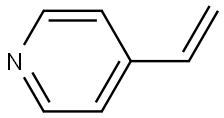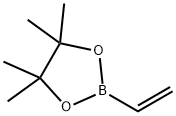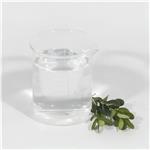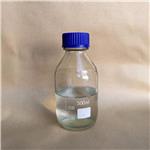Description
4-vinylpyridine (4VP) is a pyridine derivative with a vinyl group in the 4-position. It is a colorless liquid, although impure samples are often brown. This compound belongs to a class of polar vinyl monomers that are important in many applications due to the ability of their polymers to form complexes of the electron-rich pyridine ring and to form polyelectrolytes through protonation or quaternization with alkyl or aryl halides. 4VP is sometimes used in biochemistry to alkylate protein cysteine residues. When compared to other alkylation agents, such as iodoacetamide, acrylamide, and N-ethylmaleimide, 4VP is less reactive, meaning the completion rate of cysteine alkylation is lower, but it also yields fewer side reactions[1].
Chemical Properties
dark brown to yellow liquid. 2.9g can be dissolved in 100g of water at 20℃, soluble in methanol, ether, benzene, acetone, and slightly soluble in ether. When exposed to light and heat, polymerization occurs, and 0.1%-0.2% hydroquinone is often added as a polymerization inhibitor during storage.
Uses
4-Vinylpyridine acts as a co-monomer in styrene-butadiene polymers to promote adhesion between the rubber compound and supporting fibers (or cords) in tires, belts and hoses. It serves as an intermediate for manufacturing chemicals and pharmaceuticals. Further, it is used as a reagent for the modification of cysteine. In addition to this, it is used to make poly(4-vinylpyridine) and elastomers.
Preparation
4-Vinylpyridine is synthesized by reacting 4-picoline with formaldehyde to generate 4-pyridineethanol, which is then dehydrated.
Application
4-Vinylpyridine was used as a monomer in polymer chemistry and induced nonimmunological contact urticaria and allergic contact dermatitis. No crossreactivity is observed between pyridine derivatives. It can be copolymerized with many other monomers, in particular cationic monomers, such as acrylamide, acrylates, and also with other vinyl-based monomers (e.g. styrene).?
Reactions
4-Vinylpyridine belongs to a class of polar vinyl monomers with high electron affinity and can be used to synthesize poly(4-vinylpyridine) (P4VP). Its polymers are able to form complexes with electron-rich pyridine rings and can form polyelectrolytes by protonation or quaternization with alkyl or aryl halides. Anionic polymerization of vinylpyridine has been reported to undergo side reactions in both polar and nonpolar solvents, with the main side reaction being the attack of the anion on the pyridine ring of the monomer or polymer. In addition, bromate supported on P4VP in nonaqueous solutions has been used for the bromination of aromatic compounds with potassium bromide, a simple, efficient, mild, and selective method for methoxyaromatics, aniline, and phenol.
Flammability and Explosibility
Flammable
Purification Methods
6 2 . Purify the monomer by fractional distillation under a good vacuum and in a N2 atmosphere and store it in sealed ampoules under N2, and keep it in the dark at -20o. The picrate has m 175-176o. [UV: Coleman & Fuoss J Am Chem Soc 77 5472 1955, Overberger et al. J Polymer Sci 27 381 1958, Petro & Smyth J Am Chem Soc 79 6142 1957.] It is used for alkylating SH groups in peptides [Anderson & Friedman Can J Biochem 49 1042 1971, Cawins & Friedman Anal Biochem 35 489 1970]. [Beilstein 20 II 170, 20 III/IV 2887, 20/6 V 213.]
References
[1] Baskaran, D. and A. Müller. “Anionic Polymerization of Polar Vinyl Monomers.” (2012): 623-655









